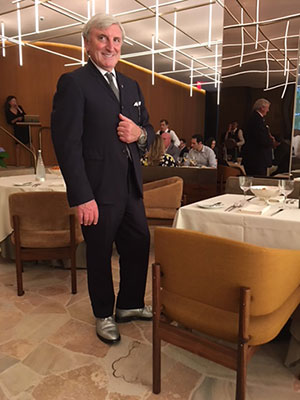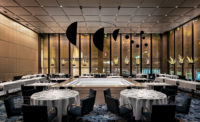Devoted fans of the former Four Seasons will find the newly reopened restaurant at 42 East 49th Street as spiffy and modern as the old one that closed two years ago – but quite different.
“There’s a saying ‘Don’t walk in your forefathers’ footsteps but seek what they were seeking,’” says restaurant partner Alex von Bidder. “It was always clear the new space could not be a copy. The challenge was to create a restaurant that reflected the 1959 original without imitating it.”

Photo © Suzanne Stephens
Bidder and co-partner Julian Niccolini went to great lengths to find a suitable space (they scouted 13) and the right architect. They asked architecture critic Paul Goldberger for help. Out of the initial list of 40 architects he suggested, they chose twelve and then invited eight to speak with them.
“It became clear we wanted someone who had never done a restaurant in the United States before,” von Bidder says, explaining how they went to the Brazilian modernist Isay Weinfeld. “I told them I thought we should turn the page and design something completely new – and still, somehow, connected to the old Four Seasons in a subtle way,” Weinfeld says.
The new restaurant is smaller, 24,000 square feet versus 30,000, and has a fairly awkward layout. The entrance foyer on East 49th Street is small, a cube sheathed —floor, ceiling and walls—in dark brown Brazilian Radica marble, with neither art nor any decoration. (“I don’t like using art as an adornment; I respect it too much for that,” Weinfeld says.) As you move to the right, a metal pocket door slides open, revealing a glamorous, glowing bar enclosing a sunken area where the bartenders serve. Weinfeld says the idea for the foyer was to create mystery, followed by the surprise of discovering the dramatic bar.
The room is a 50-foot square, with the bar in the middle, perhaps a reference to the pool in the old restaurant. Weinfeld has done the best he can with the architecture, but he was unlucky with what he inherited: pedestrian corporate architecture. Missing are the soaring spaces by Mies van der Rohe in the former home. (Here the bar is 10 feet 7 3/8 inches high; the dining room 11 feet, 1 3/4 inches.)
Weinfeld severely limited the range of materials for the bar and the long slightly elevated passageway connecting it to the dining room on the other East 48th Street side of the building: He used pale Tuscan limestone for the floor of the bar and tunnel, stainless steel columns in a warm bronze finish, panels of oxidized brass for the ceiling and walls of the tunnel and clear, teak paneling and irregularly-shaped Astera glass beads from the Czech Republic (hung on wires like curtains on the 49th Street windows) in the bar room.
The color palette is equally limited: beige, brown, bronze and gold (24-karat gold leaf glows under the thick glass bar top.) Asked why it is all so quiet, Weinfeld says, “My only concern was being able to make a simple architecture, one that speaks softly, is functional and yet is extremely pleasant, timeless. And that touches people.”
At the end of the tunnel, steps lead down to a large open dining room, which seats 110. Here the star attraction is a light installation that spans the ceiling, a geometrical cage by the London industrial designer Michael Anastassiades, with nickel-plated vertical and horizontal brass armatures illuminated by linear LEDs. The floor to ceiling windows are screened by a golden metallic mesh fabric developed for the restaurant by a lab in Holland. The floor is a patchwork of Italian Travertino rosso marble and Pietra dorata with Douglas limestone. The space is almost too calm. Weinfeld proclaims that’s on purpose, so it is the guests who are “highlighted.”
Is he happy with the results?
“Extremely,” he says. “I had the owners’ trust and confidence to develop what I imagined, and it was beautifully executed.”
Von Bidder and Niccolini are pleased but still tweaking the design. They have re-arranged all the furniture in the dining room so guests can spot who is entering. “This is, after all, a restaurant about New York,” Niccolini says. “There has to be a relationship between the restaurant and our people.”
That is certainly what the old Four Seasons at the Seagram Building was and what the new one needs to be. Only time will tell.
Wendy Moonan’s book, New York Splendor: The City’s Most Memorable Rooms has just been published by Rizzoli.












Post a comment to this article
Report Abusive Comment